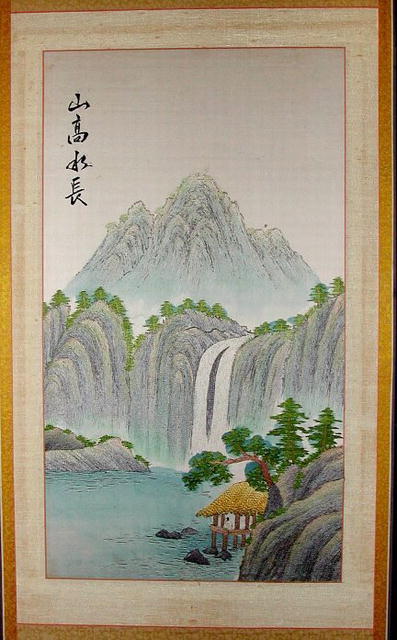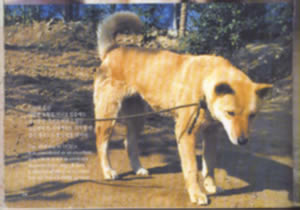The Importance of Type
The Korean Jindo has often been catagorized as a northern spitz... but there are multitudes of breeds that also fall under the
catagory, ranging the petite pomeranian to the East Siberian Laika.
The Korean Jindo has sometimes been catagorized as a pariah dog... but these include dogs such as the Israeli Canaan dog, the North American Carolina dog, the African Basenji and even all the street dogs living in the cities of practically every nation.
Asian Spitz? That includes all the Japanese breeds and the Chow-chow.
Primitive Spitz? Depending on who you ask, that includes the dingo, the shiba, and the New Guinea singing dog.
What makes the Jindo different than all these breeds? Most have the upright tail and the upright ears. A few have the exact same
color of coat as the Jindo. Some retain the "wild" and "primitive" behaviors. Some were raised in similar topological environments, with the same fauna to hunt, developing similar bodies.
Can the Jindo be simplified as "a small Akita", "an overgrown Shiba", or even "a yellow husky"?
Is the difference between the Jindo and the other breeds just an artificial, imagined separation, not based on real differences in the dogs themselves?
My answer is that there *is* a difference between the Jindo dog and these other breeds. There is a certain presence that a Jindo
dog gives off that is different from any other breed. This breed uniqueness is referred to as "type" in dog lingo. Even though the
Jindo dog was allowed to develop under natural selection due to the difficult living conditions of Jindo island, they were influenced by the preferences of the Korean people. Dogs that exemplified the traits Korean admired were helped along. It is through this Korean input that distinguishes the Jindo dog from being just one of the many primitive, pariah, or spitz dogs out there to a Korean treasure.
Until one understands how Koreans appreciate their dogs, it is very easy to lose focus on what a Jindo is and what the Jindo type is
when faced with the myraid of different Jindo styles.
The First Impression
"Natural." "Nature-made." "Naturally selected."
These are the comments used when describing the first impression given off by a Jindo. At first reading, it seems simple enough. No fur like a poodle or terrier. No head like a bulldog or greyhound. No body like a corgi or mastiff. However, when Koreans use it
to describe their Jindo, it is not enough to be satisfied with these broad generalizations.
A dog could have a double-coat, prick ears, and a body comparable to a Jindo, but it would not necessarily be considered "natural"
by Koreans.
I've noticed that different cultures have different intepretations of what would be "natural" and what would be "artificial." Different dog
owners/breeders have different intepretations of whether their breeds are "natural" or not. A breed with a man-made function but
undergoing survivial of the fittest might not be considered "natural" enough by some. A nordic breed utilized for hunting large deer,
needing to smart and agile enough to evade flying hooves, might be considered "natural" by some but not all.
Different people have different ideas about what is "natural selection." For instance, I've come across someone who insists that
wolves are not natural because they have been pushed out by man and had to adapt to living around man.
Rather than dwell on these differences (a topic more suited to those keen on sementics), I will merely say that the Jindo should be natural
according to the Korean definition of natural. Sometimes it may seem that this definition wanders out from the area of pragmatics and science and into the area of asthetics and art. Maybe so, but having a good feel for what Koreans consider "natural" will help explain why the Jindo is what it is, why some Jindos are preferred over others, and why some dogs are considered mixed.
The old bilingual Korean National Dog Association website attempted to give some background on this with the following section:
The characteristics of a nation are based on environmental climate and culture. Therefore, to rightly appreciate the
Korean indigenous dog, Jindo Dog, one needs an eye for the aesthetic sense of Korea.
 \
\
The geographical configuration of Korea is 70% mountains but they are low mountains and old so that instead of being
sharp and steep, the lines form waves and drips down. Like such soft flowing of hills and swerved pine trees every
where, simply the beauty of curve became the standard of Korean's feeling. In other words, the traditional Korean arts emphasized the softness of the curve and simplicity and instead of vibrant preferred moderate and soft colors. So, it is
obvious that the appearance of the Jindo Dog which have lived together with Koreans for many centuries would follow the
Koreans' feelings.

Photo by Woo, Mu Jong
Therefore, in observing the Jindo Dog, instead of examining up close and entangled with only the details, it is better to
take 7-8 steps back and see the Jindo Dog's body as a whole feeling its natural and bestial beauty. And if the observer
is keen, he will be able to see that every part of the Jindo dog's body is composed of curves and not an angle or a line is to be found.

 \
\